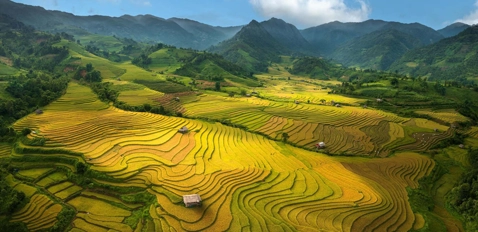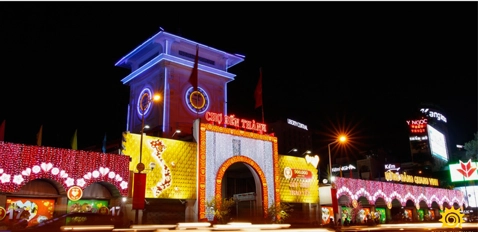Map of Can Tho: Your Ultimate Guide to Vietnam’s River Capital
Discover the Map of Can Tho, and begin your journey into the beating heart of Vietnam’s river life. More than just lines and labels, this map reveals a city where time flows with the water, and each turn holds a story of culture, taste, and tradition. Whether you’re a curious traveler or a slow explorer at heart, Can Tho promises moments both peaceful and vivid—ready to unfold at your own pace. Let this guide be the first step toward uncovering a destination where everyday life dances on the river.
Where is Can Tho and Why Is It So Special?
Located in the southwestern part of Vietnam, Can Tho is the beating heart of the Mekong Delta region—the largest rice bowl in the country and one of Southeast Asia’s most fertile agricultural zones. Stretching over 1,409 square kilometers, Can Tho is home to approximately 1.2 million people (as of 2023), making it one of the most populous city in Vietnam.
Administratively, Can Tho consists of 5 urban districts—Ninh Kieu, Binh Thuy, Cai Rang, O Mon, and Thot Not—along with 4 rural districts: Phong Dien, Co Do, Thoi Lai, and Vinh Thanh. Among them, Ninh Kieu District is the vibrant urban core, known for its bustling night markets, riverside promenades, and diverse culinary scene.
What truly makes Can Tho special is its distinctive river-based culture. The city is crisscrossed by an intricate network of canals, rivers, and arroyos, where life thrives on water. The iconic Cai Rang Floating Market, one of the largest and most famous in the Mekong Delta, is a must-visit where visitors can witness hundreds of boats selling everything from pineapples to breakfast noodles—right on the river.
Beyond its waterway wonders, Can Tho offers lush fruit orchards (especially in Phong Dien), traditional miệt vườn houses, and a tranquil rural lifestyle that gives travelers a taste of authentic southern hospitality. The city also boasts a growing infrastructure of universities, industrial zones, and tourism services—solidifying its role as a gateway to the Mekong Delta and an economic pillar of southern Vietnam.
Whether you’re drawn to the gentle rhythm of river life, the rich agricultural heritage, or the warmth of the local people, Can Tho is where nature, culture, and community flow together in perfect harmony.
When is the best time to visit Can Tho?
Can Tho, like much of the Mekong Delta, has a tropical monsoon climate, with two main seasons: the dry season (December to April) and the rainy season (May to November). But don’t let the rain discourage you—each season offers its own kind of magic.
Flood Season (September–November)
Known locally as “mùa nước nổi”, this is when the rivers rise and the waterways come to life. It’s the best time for boat tours, floating market visits, and witnessing the delta’s unique aquatic lifestyle. The scenery becomes more poetic, with vast water landscapes and blooming water lilies—a paradise for photographers.
Fruit Season (May–August)
This is when Can Tho’s orchards burst with tropical fruits: mangoes, rambutans, durians, mangosteens, and more. Visiting Phong Dien or My Khanh orchards during this period means you can pick fresh fruit, enjoy shaded garden meals, and learn about traditional farming culture.
Festival Season (January–March)
Coinciding with Tet (Lunar New Year) and other local festivals, this is a great time to experience Southern Vietnamese culture. Streets are lively with lion dances, boat races, and flower markets, while the weather is cool and dry—ideal for relaxing or sightseeing.
Travel Tips by Interest
For stunning photos: Visit during September–November for misty rivers, lotus blooms, and sunrise shots on the floating market.
For foodies: Come in summer (May–August) to indulge in fresh tropical fruit and street food at its best.
For a relaxing retreat: The dry months (December–March) offer pleasant weather, perfect for cruising, biking, and homestays.
What to see and do in Can Tho?
Cai Rang Floating Market
The largest and most iconic floating market in the Mekong Delta, Cai Rang comes alive at dawn with boats selling fresh produce, noodles, and coffee. It’s a vibrant snapshot of local river life and a must-see for early risers and photographers alike.
Ninh Kieu Wharf
Located in the heart of the city, Ninh Kieu Wharf offers a scenic promenade along the Hau River. It’s a favorite spot for sunset strolls, street food, night markets, and river cruises. The area also features Can Tho’s pedestrian bridge, lit up beautifully at night.
My Khanh Fruit Garden
Just 12 km from the city center, this eco-tourism village is full of tropical fruit trees, traditional southern houses, and rural games. Visitors can pick fruits right from the trees, enjoy rustic meals, and even stay overnight in thatched-roof cottages.
Truc Lam Phuong Nam Zen Monastery
One of the largest Buddhist monasteries in the Mekong Delta, this peaceful retreat features traditional Vietnamese architecture, serene lotus ponds, and a tranquil atmosphere—perfect for meditation or quiet reflection away from the city’s bustle.
Traditional Rice Noodle Workshop
Visit a local hủ tiếu workshop to see how Can Tho’s famous rice noodles are made by hand. From soaking rice to drying thin noodle sheets under the sun, the process is both fascinating and flavorful—some tours even let you taste fresh noodles on-site.
Binh Thuy Ancient House
Built in 1870, this well-preserved French colonial house blends Western and Vietnamese architecture. It has been featured in many films, including The Lover. Visitors can admire antique furniture, vintage décor, and stories of a bygone era.
Ninh Kieu Night Market
Just steps from Ninh Kieu Wharf, this lively night market is the perfect place to taste local snacks, shop for souvenirs, and soak in the city’s energy after dark. The area is especially vibrant on weekends, with live music, street performers, and riverside cafés.
Ong Pagoda
Built by the Chinese community in the late 19th century, Ong Pagoda is a colorful Taoist temple dedicated to Quan Cong. With ornate carvings, spiral incense coils, and a spiritual atmosphere, it offers a glimpse into Can Tho’s multicultural heritage.
Ông Đề Ecotourism Village
A hidden gem for nature lovers and families, this eco-village features fish ponds, zip lines, water games, and thatched-roof eateries. It’s a fun, hands-on experience of rural Mekong life just a short ride from the city center.
Bang Lang Stork Garden
Located in Thot Not District, this sanctuary is home to thousands of storks and other waterbirds. The best time to visit is early morning or late afternoon, when flocks of birds fly across the wetlands—creating a peaceful, almost surreal scene.
Con Son Islet Ecotourism Area
Located in the middle of the Hau River, Con Son Islet is a peaceful ecotourism destination offering an authentic slice of Mekong life. Visitors can tour floating fish farms, take part in traditional cake-making workshops, taste fresh fruits from local orchards, and enjoy warm hospitality at riverside homestays. It’s a perfect escape for those seeking nature, culture, and simplicity.
What to eat in Can Tho?
If there’s one way to truly understand the soul of Can Tho, it’s through its food. Every dish here tells a story—of river life, of family recipes passed down generations, of flavors shaped by the Mekong’s gentle flow.
Nem nướng Cái Răng (Grilled Pork Rolls)
Grilled pork rolls served with thin rice paper, fresh herbs, and a signature dipping sauce made from peanuts and fermented soybeans. A beloved street food that’s best enjoyed fresh from the charcoal grill in Cái Răng district.
Bánh cống (Mung Bean & Pork Deep-Fried Fritters)
A deep-fried mung bean and pork fritter made with rice flour and stuffed inside a crispy mold. Crunchy on the outside, savory and soft inside—served with pickled veggies and fish sauce.
Lẩu vịt nấu chao (Duck Hotpot with Fermented Tofu)
A flavorful hotpot made with tender duck simmered in fermented tofu (chao), accompanied by taro, water spinach, and noodles. It’s rich, creamy, and perfect for group dining.
Bánh xèo Cần Thơ (Crispy Mekong-Style Rice Pancake)
Southern-style sizzling pancake filled with shrimp, pork, and bean sprouts. Larger than its central cousin, it’s folded in half and eaten wrapped in greens with sweet fish sauce.
Lẩu bần Phù Sa (Bần Hotpot)
A sweet-sour Mekong-style hotpot made from bần (a local sour fruit), cooked with fish, shrimp, and river vegetables. Often enjoyed at riverside restaurants like Phù Sa eco-resort.
Bánh tráng Thuận Hưng (Thuận Hưng Rice Paper)
A famous rice paper from Thuận Hưng ward, sun-dried and grilled until crisp. It’s both a snack and a cooking staple, often served with dried fish or dipped in chili salt.
Ốc nướng tiêu xanh (Grilled River Snails with Green Pepper)
Fresh river snails grilled with green pepper and herbs. The heat from the pepper complements the chewy texture of the snail, making it a favorite among spicy food lovers.
Cơm cháy kho quẹt (Crispy Rice with Caramelized Dipping Sauce)
Crispy rice paired with a rich caramelized dip made of braised pork, dried shrimp, and pepper. Eaten with boiled veggies, it’s rustic, salty-sweet, and addictive.
Cá lóc nướng trui (Charcoal-Grilled Snakehead)
Snakehead fish grilled whole over open fire, scales and all. Served with rice paper, herbs, and a tangy dipping sauce—this dish is smoky, earthy, and purely Mekong.
Fresh Fruits from Cai Rang Floating Market
Wake up early and cruise through Cai Rang market to taste sun-ripened fruits right off the boat: pineapples, mangosteens, rambutans, and star apples—picked fresh, sold on the water.
Where to eat in Can Tho?
You can sample Can Tho’s signature dishes at Ninh Kieu Night Market, enjoy riverside dining with a view, or taste rustic home-cooked meals at local homestays. But for a truly immersive experience, why not cook it yourself?
Join a culinary tour with cooking class and dive into the heart of Mekong food culture. Your day begins with a scenic countryside ride from Can Tho to a tranquil village, passing rice paddies and fruit orchards. You’ll then visit a vibrant local market to handpick fresh ingredients, before crossing a traditional ferry to reach a riverside kitchen.
There, a local chef will guide you through a hands-on cooking class, sharing family recipes and techniques passed down through generations. After preparing traditional dishes together, you’ll sit down to enjoy your creations in a peaceful rural setting—a true farm-to-table experience in the Mekong Delta.
How to get to Can Tho From Ho Chi Minh City?
Can Tho is around 165 km southwest of Ho Chi Minh City, and the drive takes 3–4 hours. You can travel by:
Sleeper bus: departs hourly from District 5. Tickets from 150,000 VND (~6 USD).
Private car or van: Ideal for groups or families who want comfort and flexibility.
Motorbike: Adventurous option for experienced riders—expect scenic roads and lots of bridges!
Once you’ve arrived in Can Tho, getting around is easy and enjoyable thanks to a variety of local transport options:
Motorbike rental: 120,000–180,000 VND/day. A great way to explore the countryside.
Taxi & Grab: Available in the city center and at the airport. Reliable for short trips.
Boat tours: Essential for visiting the floating markets and riverside villages. Tours can be arranged at Ninh Kieu Wharf.
Bicycle: Some homestays and eco-lodges offer free bikes—perfect for a peaceful ride along the canals.
Travel Tips for Can Tho
Start your day early: Floating markets are most active from 5:30–7:00 AM, so set your alarm for a truly local experience.
Bring cash: Most small vendors, boat services, and countryside eateries do not accept cards.
Use Grab for easy transport: Safer and often cheaper than traditional taxis in the city center.
Pack light, breathable clothing: The weather is warm and humid year-round—opt for cotton, a hat, and sandals.
Stay hydrated: Always carry a reusable water bottle, especially when exploring markets or cycling through the countryside.
Map of Can Tho: Ready to Discover the Soul of the Mekong?
In Can Tho, you don’t just visit—you slowly belong. You won’t find towering skyscrapers or flashy attractions here. What you’ll find instead is something quieter, deeper—a city that flows at the pace of the river and welcomes you with the kindness of a neighbor.
Send us your comments about : Map of Can Tho: Your Ultimate Guide to Vietnam’s River Capital
Required fields *
You might also be interested
Travel ideas
Need some inspiration? Discover some of the best tours in Vietnam, which are highly appreciated by our clients. An excellent starting point to help you choose the right trip to Vietnam, Laos, Cambodia, Burma or Thailand, whether you are traveling alone, as a couple, as a family or with friends.
And because this trip is yours, feel free to customize it as you wish!
Vietnam Cambodia Itinerary 14 Days
Hanoi – Hoa Binh – Mai Chau – Ninh Binh – Halong bay – Hue - Danang – Hoian – Saigon – Ben Tre - Can Tho – Saigon - Siem Reap Angkor - Tonlé Sap - Siem Reap – Ta Prohm - Departure
Vietnam 14 Day Itinerary
Vietnam 14-day itinerary covers the country’s top highlights and quintessential experiences for an unforgettable journey.
Honeymoon Tour Pakcages In Vietnam 12 Days
Saigon Arrival - City Tour – Mekong Delta – Danang – Hoian - by flight - Da Nang – Hanoi - by flight – Halong - overnight on junk – Departure
Authentic Hoang Su Phi Trekking Tours
Hoang Su Phi trekking tours take you to stunning terraces, meet few tourists, connect with locals and enjoy authentic culture.
Best Nha Trang Beach Tour 4 Days
Saigon/Hanoi – Nha Trang relaxation – Saigon/Hanoi – Departure
Mekong Delta Bike Tour Itinerary 7 Days
Cycle through the Mekong Delta in 7 days, discovering floating markets, orchards, craft villages, and tranquil green islands.
Are you interested in this tour?































Comment